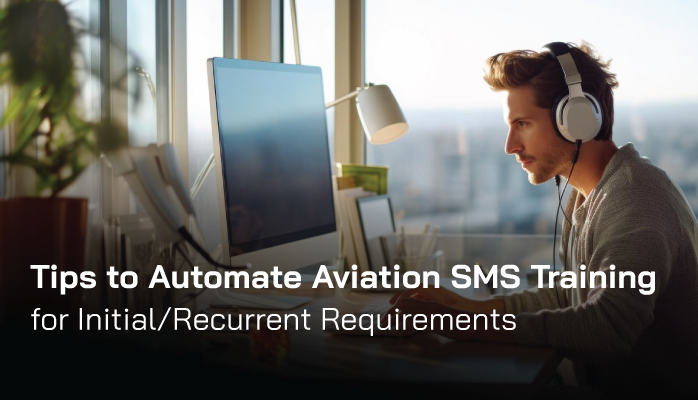Benefits of Automated SMS Training for Initial and Recurrent Training Requirements

During the implementation of formal aviation safety management systems (SMS), service providers are expected to develop and deliver SMS training to employees in every implementation phase except the first phase. For example:
- Phase II: Deliver training relevant to reactive risk management processes;
- Phase III: Deliver training relevant to reactive risk management processes; and
- Phase IV: Develop training relevant to operational safety assurance.
Related Aviation SMS Training Articles
- What Is Aviation Safety Training in Aviation SMS - Includes Videos to Use
- 10 Things You Need to Know About Aviation Safety Training
- 6 Tips to Improve Aviation SMS Training Courses
SMS Training Must Reflect Employee Role in SMS
The level of SMS training for each employee must be delivered that is commensurate to the role each employee plays in the aviation SMS. For example, all employees should have an SMS introductory course that includes hazard identification and hazard reporting processes. Operational department heads will need training on risk management processes and how to document their risk management activities. Safety teams and the accountable executive will need training on:
- Aviation SMS implementation;
- SMS documentation requirements; and
- How to monitor SMS performance.
These examples are examples only. Please don't consider it an exhaustive list, as I just pulled them from the top of my head.
Costs of Aviation SMS Training - Not Always Financial
Aviation safety training can be a logistical and financial nightmare. This is especially true in larger companies or in organizations where financial/human resources are stretched thin.
Training not only costs money, but it also comes at the expense of workers’ duties because they will have to miss work in order to complete training. This means that revenue-generating activities will need to be considered when addressing the real costs of SMS training.
Some organizations address this issue by requiring employees to complete automated, online training from their home – off the clock. However, this is definitely a less-than-desirable solution and a definite non-starter with a "unionized workforce."
Benefits of Automated, Online SMS Training

In many cases, automated SMS training is a much more safety-culture-friendly and sustainable way to fulfill SMS training requirements. Automated, online SMS training:
- Requires very little logistical effort;
- Is automatically generated for a user to complete at their convenience;
- Eliminates travel time and "getting started" costs; and
- Cuts most overhead costs generally needed for training, such as training rooms, refreshments, etc.
With these kinds of benefits, why don’t more companies adopt automated SMS training for their SMS implementations? In general, the reasons we hear are:
- It’s a big change (and people don’t like change);
- Lack of direction and know-how for creating automated training;
- Fear of inability to manage automated training;
- Concerns that automated, online training does not meet regulatory compliance; and
- Other challenges for automating recurring SMS training.
Related Aviation SMS Training Articles
- Where to Focus Hazard Identification Training & Risk Mitigation
- How to Be Compliant With ICAO Training and Education Requirements
- 5 Signs of Good Aviation Risk Management Training
Challenges of Recurring SMS Training
Despite the numerous benefits of automated SMS training for initial and recurring training requirements, there are several distinct challenges as well:
- Monitoring automated training, such as expiration periods and notifications to training managers;
- Creating effective training content and workflows;
- Managing SMS training documentation for auditors; and
- Creating and publishing automated training curriculum.
Aviation SMS training curriculum is best developed and created by industry experts with experience with training automation. Yet organizations who wish to address and overcome these challenges will cut down on the headache and financial burden of manual SMS training and also for tracking this SMS training.
Here are some suggested techniques to establish and manage an acceptable automated SMS training program.
Require (End of) Training Assessments
Automated SMS training is done at the convenience of each employee, and it is completed alone. This is why the most pressing question organizations usually have when considering training automation is: how are we going to manage and monitor it.
A simple and effective solution is to include "end of training assessments" as a part of the automated training process. Or, these assessments can become part of the automated training in and of themselves. These assessments should be:
- Short, such as 5-10 questions;
- Multiple choice;
- Automatically scored and documented; and
- (if applicable) Created in direct reference to the training.
Assessments give safety managers documentable evidence of training performance that will satisfy auditors.
Use Safety Training Articles Library for Recurrent SMS Training

There are many SMS-relevant training articles available online for company use. For example, organizations such as Boeing and the FAA (among others) have contacted us to use our articles as training materials. With such an abundance of SMS-relevant articles you can:
- Compile all desired articles into one location for your company to access;
- Organize all SMS-related articles by “type,” such as hazard identification, human factors, etc.;
- Set yearly requirements for each position in your company to read a certain number of articles from relevant article “types”; and
- Optionally require proof of reading, such as a summary, assessment, etc.
One of the major benefits of this method of automated recurrent SMS training is that it only requires management's time to choose the articles and review performance, both of which should not be too burdensome or time-consuming.
Moreover, employees get to choose (within prescribed boundaries) which articles appeal to them the most. This is a great incentive to engage employees with safety. There is also no reason you can’t include training videos in the training articles library as well.
Of course, if you are using external article resources you should always ask permission from the article owners, and give credit where applicable.
Related Aviation SMS Recurrent Training Articles
- How Recurrent Aviation SMS Training Makes Good Business Sense
- How Aviation Safety Articles Satisfies Recurring SMS Training Requirements
Use Aviation SMS Software
Aviation SMS software and other similar web applications provide natural forums in which to provide both initial and recurrent SMS training. These web applications can be full-fledged SMS software, or point solutions, such as software dedicated exclusively to training or employee skill assessments.
The upside of such a strategy is that:
- Your training data is secure and easily accessible;
- Data resides typically in a centralized database instead of spreadsheets on various computers;
- Complex training data will always be readily available;
- Data charting tools should be built into the software/application, allowing you to easily create reports;
- Provide the best method of regulatory compliance, as software/apps are commonly built to be compliant with existing SMS regulations; and
- They require the least amount of manual work.
The only downside is that you will be required to learn a new application, and this method of automated training will be more expensive than other automated strategies (though only marginally).
Final Thought: What You Need to Move From Manual to Automated Safety Training
Making the jump from manual to automated SMS training is smooth, however, it requires three things:
- Upper management support;
- A clear plan of what kind of automated training you are going to use (i.e. articles, videos, assessments, software);
- A clear plan of how you are going to implement the new training; and
- A plan for how to effectively notify employees of training changes (be positive!).
Here are some training resources that may prove very helpful in demonstrating the recommendations from this article:
Last updated in December 2025.







